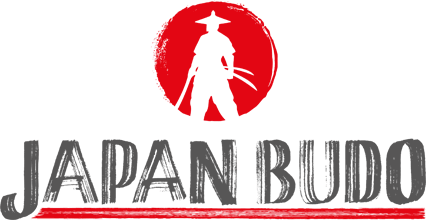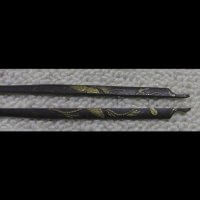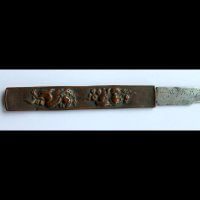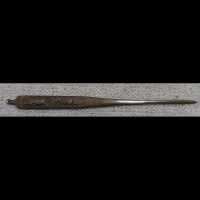Ancient Kogatana and Kogai
Here you will find an exclusive selection of antique Kogatana and Kogai from Japan.
Showing all 3 resultsSorted by popularity
Showing all 3 resultsSorted by popularity
Kogatana
Kogatana are by-knives that were often carried in a special recess in the scabbard of samurai swords.
The name is made up of the words Ko, which means small, and Katana, which means sword/blade.
They are often found on wakizashi, but also on katana and tanto. They are a popular addition to exclusive pieces in particular because they enhance the overall look.
For mounts (Koshirae) from old samurai swords sometimes an empty recess can be seen because the by-knife has been lost over the years.
The by-knives were not intended for combat, but rather as tools for carving and the like.
They can vary in length, but are usually between 15 and 25 cm long.
The cut-outs in Japanese stitch blades (Tsuba) are available so that Kogatana and the Kogai explained later can be inserted through them.
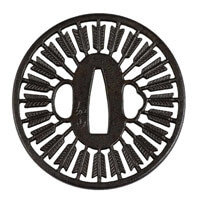
Kogatana consist of a simple blade. This is relatively small and simple compared to other sword blades.
However, the blade is often engraved with characters and is a very popular collector's item if it was made by a renowned craftsman.
The second component is the handle (kozuka). The handles are usually made of soft metal and lavishly decorated.
Just like tsuba, they offer an opportunity for artistic design and many of them are true works of art in the smallest of spaces.
The characteristics of Kogatana make them a very popular collector's item. Compared to other samurai collectibles, they are even relatively cheap on the market!
Kogai
Kogai are tools with a similar shape to a long needle. In some examples (much rarer than kogatana) they were also placed in a recess in the scabbard.
The second notch on the Japanese blade (tsuba) is for kogai.
Kogai could have different functions, for example as chopsticks or dressing needles.
They are available in different designs. Many of them have a flat handle and therefore offer space for artistic elaboration. Just like the kogatana described above.
